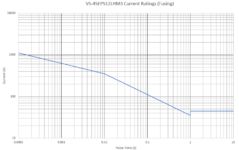ElecDesigner
Member level 5
I'm using diodes that will conduct very high currents for tens or hundreds of us a few times per second only so am looking at very short pulse capability.
Diodes such as this one.....
..give max I2t ratings for pulses above 10ms length and I2(root)t ratings for shorter than 10ms. The above 10ms rating is normally a 1/10th of the other rating which makes the 10ms numbers tie up.
My question is very simple... if only the above 10ms value is specified, do we assume the below 10ms value is 10 times that in all cases. See the attached graph.
Diodes such as this one.....
..give max I2t ratings for pulses above 10ms length and I2(root)t ratings for shorter than 10ms. The above 10ms rating is normally a 1/10th of the other rating which makes the 10ms numbers tie up.
My question is very simple... if only the above 10ms value is specified, do we assume the below 10ms value is 10 times that in all cases. See the attached graph.
Attachments
Last edited:
